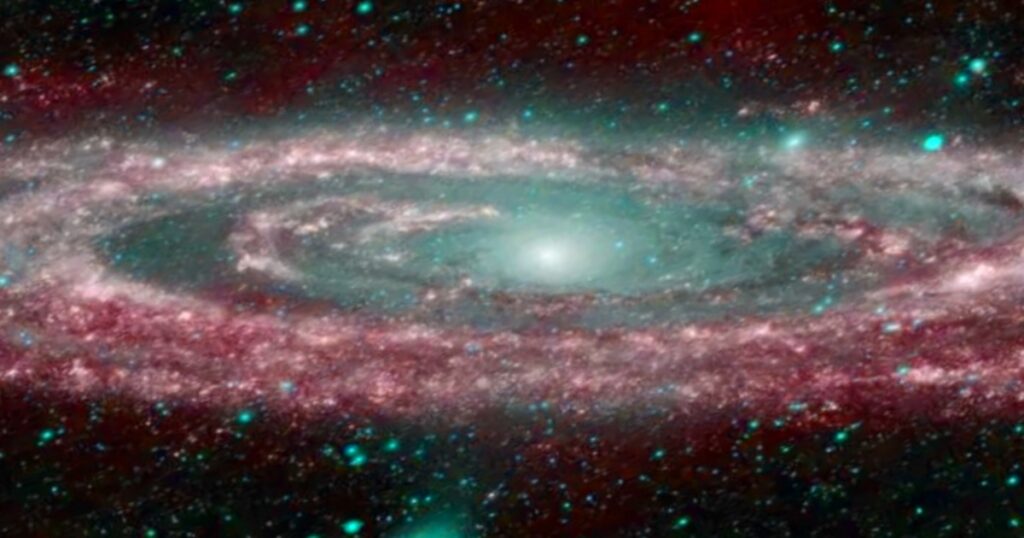The Andromeda Galaxy is a barred spiral galaxy that is the closest major galaxy to the Milky Way. It is the other prominent member of our local galaxy collection, the Local Group.
It was formerly known as the Andromeda Nebula and is also known as Messier 31, M31, and NGC 224. Andromeda has a radius of roughly 110,000 light years and a distance from Earth of approximately 2.537 million light years.

NASA estimates that the size of Andromeda makes it the biggest galaxy in the Local Group. However, NASA claims that its mass is about the same as, if not less than, that of the Milky Way.
The galaxy may be between five and ten billion years old, according to scientists. However, a 2018 study suggests that the Andromeda Galaxy may not have existed in its current shape until two or three billion years ago when two smaller galaxies that were orbiting one other merged to form the present-day Andromeda Galaxy.
When and Who Discovered the Andromeda Galaxy?
The first documented recognition of Andromeda dates back to the 10th century, appearing in the writings of the Persian astronomer Al-Sufi. In 1764, French astronomer Charles Messier, while cataloging celestial objects to avoid confusion with comets, included a faint, fuzzy patch in the constellation Andromeda. This entry, now known as Messier 31 (M31) or NGC 224, would be recognized as the Andromeda Galaxy.
Messier, along with other astronomers of the time, lacked the technology to definitively classify M31 as a galaxy. It wasn’t until the early 20th century, with the development of powerful telescopes, that Edwin Hubble’s observations of Cepheid variable stars within Andromeda solidified its status as a distinct galaxy.
Hubble’s groundbreaking work not only confirmed the existence of other galaxies beyond our own Milky Way but also laid the foundation for modern cosmology.
What is the Structure (Anatomy) of the Andromeda Galaxy?

The wonderful constellation of Andromeda Galaxy is displayed in the shape of a barred spiral. The central bar of stars halts down to the outer part of the galaxy, making it curve out into spiral arms that hold the myriad of star birth.
A stellar bulge is essentially a dense and bulging region located in the interior of the galaxy containing a supermassive black hole. Living in a galaxy means having to cover you all around, with dark matter and hot gas. It has a diameter of roughly 260,000 light-years, compared to our Milky Way’s 200,000 light-years.
In clear skies, you may see Andromeda from Earth without the need for a telescope. Finding the “W” formed by the constellation Cassiopeia, which points in the direction of Andromeda, is a simple method of finding it.
In terms of its overall length, Andromeda is greater than the Milky Way. It’s difficult to determine which of the two galaxies is more massive, though, as their masses are essentially comparable.
Is there a Possibility of Collision between Milky Way and Andromeda?
A 2019 study found that because Andromeda and the Milky Way are slowly approaching one another, scientists believe that they will collide in roughly 4.5 billion years. As per NASA, the two galaxies will probably merge to form a massive oval or elliptical galaxy.
The solar system will likely remain mostly unaltered. We could be dragged out of the galaxy’s center or completely expelled from it. Since stars are so far away, it is quite unlikely that they will collide.
Andromeda Galaxy as compared to Alcyoneus Galaxy:
Andromeda Galaxy Vs. Alcyoneus Galaxy
| Feature | Andromeda Galaxy (M31) | Alcyoneus Galaxy |
|---|---|---|
| Galaxy Type | Barred Spiral Galaxy | Radio Galaxy |
| Size | Large spiral galaxy; diameter (152,000 light-years) | Significantly larger overall, but the glowing radio lobes extend much farther (estimated diameter of radio lobes: 16 million light-years) |
| Visible Light | Emits visible light like a typical spiral galaxy | Primarily observed through radio waves; faint optical emissions might exist but are challenging to detect |
| Structure | Well-defined barred spiral structure with prominent spiral arms | Central galaxy is likely an elliptical galaxy with vast radio lobes stretching outward |
| Star Formation | Active star formation, particularly in the spiral arms | Star formation is likely not a dominant process in the central galaxy |
| Distance | Approximately 2.5 million light-years away | Approximately 3.5 billion light-years away |
| Environment | Resides in the Local Group, a smaller group of galaxies | Resides in a less dense environment compared to the Andromeda Galaxy |
Conclusion:
The Andromeda Galaxy continues to be a source of fascination for astronomers. Studying this celestial neighbor allows us to learn more about our own Milky Way’s structure, evolution, and potential future.
With the help of powerful telescopes like the Hubble Space Telescope and James Webb Space Telescope, scientists are delving deeper into Andromeda’s mysteries, uncovering details about its star formation regions, black hole, and potential for harboring planets.
